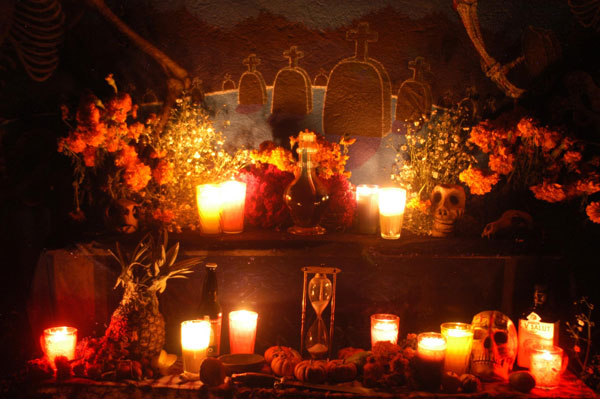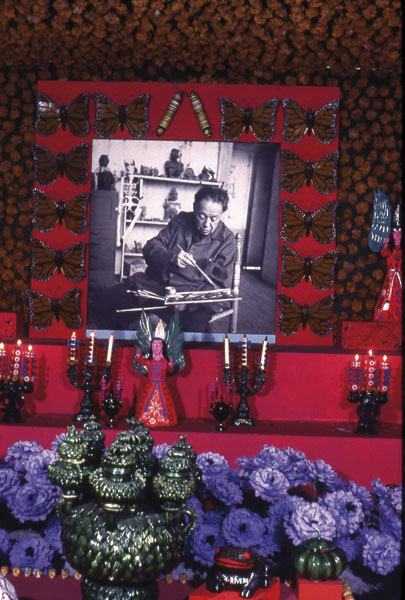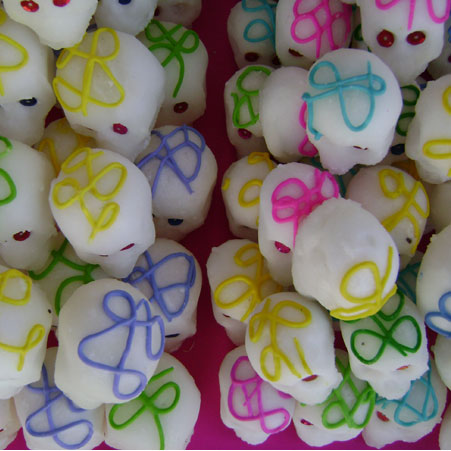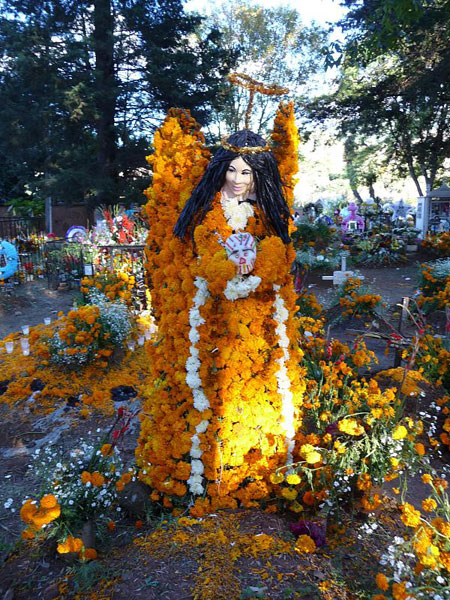
Day of the Dead alter, ofrenda, with candles and flowers, in Bosque Village in Michocan. Photo by Marie Oaks.
Day of the Dead is celebrated in Mexico, Nov 1 and 2, it is a holiday of great significance in Mexican culture. Families honor their loved ones who have passed on, with alters and offerings in their homes and in cemeteries. It is a time, not of sadness, but of joy and happiness because it is a day the dead return to visit. Entire families gather at grave sites on the nights of November first and second to honor their dead and invite them back to visit. They spend hours sometimes until very late at night, telling stories and catching up with their extended families alive and dead. After the cemetery they go back home to enjoy a meal together and continue the celebration.
Alters of offerings (Ofrendas) are built in the homes to honor loved ones or an esteemed person who has died. The alters hold photographs of the deceased along with things they enjoyed or objects that are symbolically representative of them. A cigar for Tio Jose who smoked like a chimney, a Corona for Tia Lupe who loved her beer. Food and snacks are also placed on the ofrendas to feed the dead when they return from their long journey.
Ofrendas are varied and often created with great precision and originality, but there are a few elements common to ofrendas across Mexico. Calaveras (skeletons) are the recognizable symbol of day of the dead, the images of skeletons and skulls synonymous with death in Mexico. They are seen in ceramic versions, dressed in clothes and posed theatrically, called catrinas. Skulls are made out of sugar, chocolate or covered in amaranth or sesame seeds for a sweet treat. Often the skulls will have names on them for people who have passed one, or you can buy one for yourself.
The alter will have candles, tapers and votive candles, left lit during the festivities. The alter and the area surrounding it will usually be filled with colorful flowers. The most common are the bright gold marigolds, but you also have white chrysanthemums and red gladiolas, as well as other brightly colored and fragrant flowers. During the week before Day of the Dead you will see the markets in Mexico bursting with these types of flowers. Bread of the Dead (Pan de Muerto) is a typical sweet bread flavored with anise or orange or other regional flavors. It is often baked into the shapes of people or intricately decorated. The bread rolls or loaves sometimes have a small plastic doll or figure inserted into it, and every region has their own traditions. The bread is left on the alter to feed the returning souls, but the living enjoy it too. Found in any office supply, stationary or paper store (papeleria) in Mexico, colorful tissue paper with cut out shapes and scenes of skeletons and revelry, (Papel picado), are hung like banners from the ceilings or over the alters. Copal, is a resin from tree sap that is turned into a ceremonial incense, it is burned filling the air with aromatic smoke.
Most families make their own alters, but you can see collective alters in many restaurants or offices and even cities and communities make their own collective ofrendas, some as large as entire plazas, filled with flowers and food. Day of the Dead is a wonderful time to visit Mexico, a great chance to learn about Mexican culture and a glimpse into a tradition that has been practiced in Mexico for centuries.
You can read more about Mexico´s Day of the Dead tradition in the ADIP archives: El Día de los Muertos in Zihuatanejo, Dia de Los Muertos, Day of the Dead







